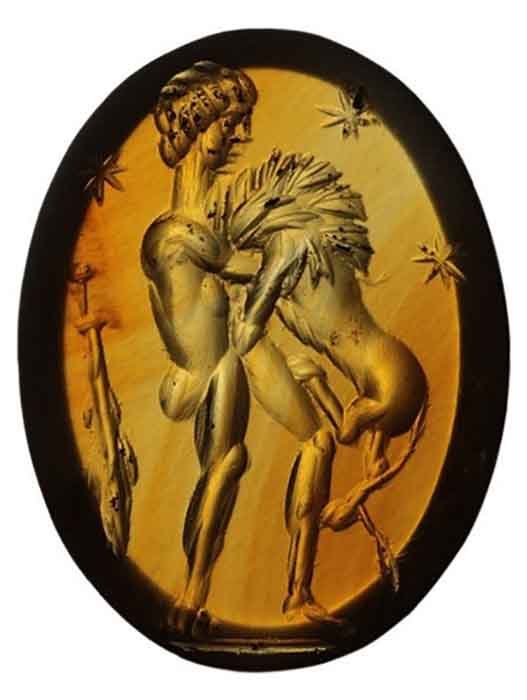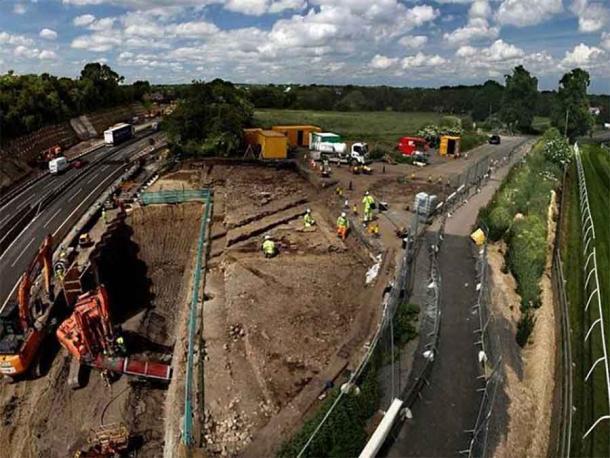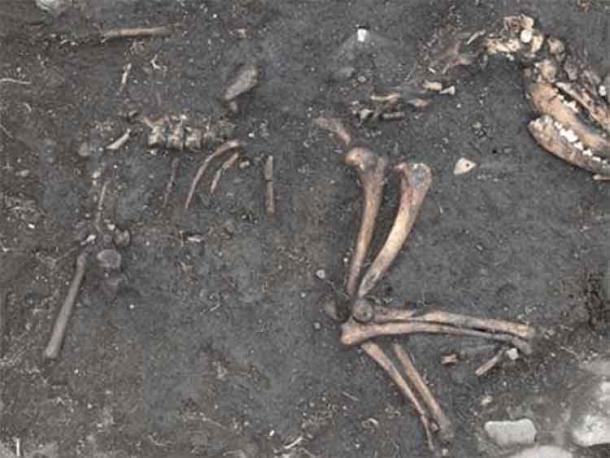
Roman Fort Treasure Trove Includes Britain’s Oldest Pistachio Nut
Cataractonium is situated about a mile from the modern-day Catterick village in North Yorkshire, England. Dating to around 70 AD this Roman fort and settlement was discovered when the A1 road was being widened, where the ancient “Dere Street” route crossed the River Swale. In 2018 archaeologists completed their study of the site and logged 400 years of continuous occupation, represented by 62,000 objects, many of which were described as “rare and exotic items imported from the Mediterranean and North Africa”.

A carnelian intaglio depicting Hercules and a lion. (OGL 3.0)
Amazing Finds at the Roman Fort
A new governmental article about the site says the treasures included a carved phallus on a reused bridge stone, incense burners, and a carnelian intaglio depicting Hercules and a lion, which would have been set into a ring. Abrooch depicting a hare, and an Anglo-Saxon dog burial with a perforated bone tag at the neck were among the unique items discovered at the site.
- Ancient Roman fort in England may have been constructed to pay homage to Mithra or Sol Invictus
- Hoard of Roman Coins Leads to the Discovery of Important Site in England
However, located south of the Swale, in a Roman storage depot, “with two timber granaries, a stock enclosure and a well,” archaeologists also found the remains of a basket containing a single pistachio nut, the oldest one ever discovered in Britain.

Archaeologists found the oldest pistachio nut in Britain at the Roman fort. (OGL 3.0)
High Quality Buildings on an Old Straight Track
When the Catterick bypass was being built in the 1950s road workers uncovered the remains of an inn with a bathroom. Archaeologists discovered wide cobble-and-clay wall foundations and they followed them to the remains of the north gate house, which subsequently led them to the stone bridge that allowed Dere Street to cross the River Swale. With over 62,000 artifacts having now been revealed, the latest study demonstrated the settlement “was much more than a stopping point, with high-quality buildings continuing well into the 4th century,” according to the government press release.
 J
J
Excavations of the Roman fortified settlement. (OGL 3.0)
Cataractonium “wasn’t a typical vicus (settlement that develops round a fort),” according to Dr. Jonathan Shipley, AECOM principal heritage consultant. He explains that after the fortified settlement was abandoned it had become self-sustaining, in his own words, “it big enough to survive by itself.” And because of where this fortified settlement is located the professor suggests it can possibly be “attributed to Septimus Severus’s advance north towards Caledonia in AD 209-210”.
- Roman Fort Discovered Hidden Beneath English Bus Station
- Aquincum: Exploring the Ancient Roman City Under Modern-day Budapest
Respecting the Dead Who Disrespected Britain
Dr. Jonathan Shipley explained that recent excavations were restricted to a 300-meter (984.25 ft.) trench that was excavated across the site to minimize disruption to burials. A densely packed cemetery contained “232 burials and 17 cremations, used from the late 1st century AD through to the mid-5th century AD,” according to the government statement. Besides the Anglo-Saxon dog burial being unearthed a cremation was discovered in the back gardens of a building.

An Anglo-Saxon dog burial. (OGL 3.0)
Furthermore, the professor said the remains of the building’s residents included “a possible family group - a man and woman with three children,” with one person having “a stack of nine coins in their mouth while two others were “associated with fish hooks”.
In conclusion, Cataractonium appears to have been a Northern supply hub from the mid-3rd century until the collapse of the empire in Britain 200 years later. The excavators dug up large commercial ovens fit to feed armies, and a range of open-fronted stone and timber structures, all located along the main road. These excavations at Cataractoniumhave essentially revealed new evidence for the extent of a Roman roadside settlement at Bainesse, and for an enclosure complex to the west, “which served as farmland to supply local and military demands.”
And if you want to see some of the vast collection of Roman and pre Roman artifacts, they are being displayed at the Yorkshire Museum.
Top Image: Excavations at the Cataractonium Roman fort and settlement in England. Source: Highways England
By Ashley Cowie















